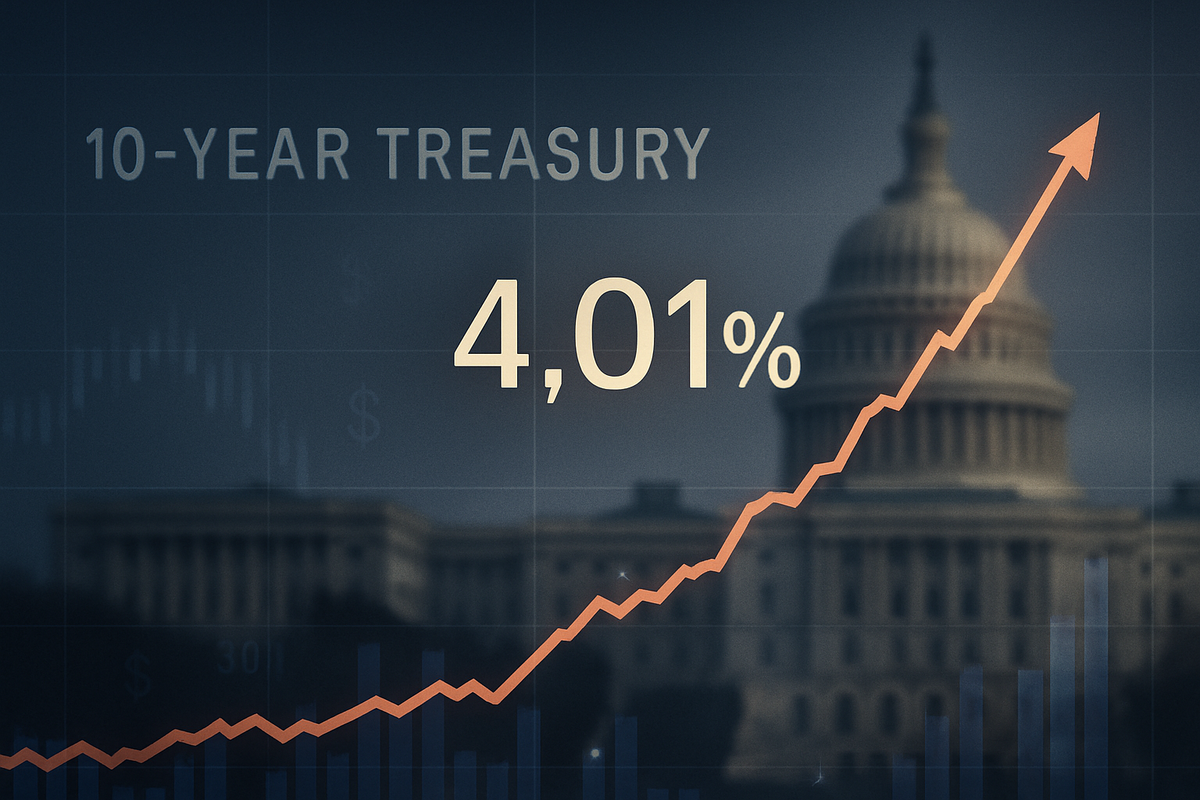
The US 10-year Treasury yield, a critical barometer for global financial markets, registered an increase of 3.5 basis points today, reaching 4.01%. This uptick, occurring on October 17, 2025, is more than just a numerical adjustment; it signals a nuanced shift in market sentiment and carries significant implications for borrowing costs across the economy. As a key indicator, the 4.01% mark reflects a complex interplay of investor anxieties, Federal Reserve policy expectations, and underlying economic realities, setting a cautious tone for the immediate future.
This movement in the benchmark yield suggests a recalibration of investor outlook, balancing recent stabilization in equity markets with persistent concerns over credit risk and the trajectory of monetary policy. For consumers and corporations alike, the rise in yields translates directly into higher costs for long-term borrowing, impacting everything from mortgage rates to corporate debt issuance and government financing. The financial landscape is thus poised for adjustments as market participants digest the implications of this pivotal yield level.
Yield's Ascent: A Closer Look at Market Dynamics and Key Influencers
The ascent of the US 10-year Treasury yield to 4.01% on October 17, 2025, marks a significant moment in an already volatile financial period. This specific movement, a 3.5 basis point increase, comes amidst a backdrop of mixed signals, where equity markets have shown signs of stabilization, yet underlying anxieties persist. Earlier in the week, the yield had dipped below 4%, driven by strong expectations of imminent Federal Reserve rate cuts, but the current rebound suggests a tempering of that dovish enthusiasm or a reaction to other market forces.
The timeline leading up to this moment has been characterized by sharp swings. The week began with a rally in stocks, fueled by robust bank earnings and an optimistic outlook for Fed easing. However, this optimism was quickly tempered by increased volatility, with the CBOE Volatility Index (VIX) reaching a six-month high earlier in the week, reflecting heightened fears over potential credit defaults and the health of regional banks. This "risk-off" sentiment has driven a "sharp flight to safety" into US Treasuries at times, paradoxically pushing yields lower. However, the current rise above 4% indicates that other factors, possibly inflation concerns or a re-evaluation of the pace of Fed easing, are now exerting upward pressure.
Key players and stakeholders closely watching this yield movement include the Federal Reserve, whose future monetary policy decisions are heavily scrutinized; institutional investors and bond traders, who actively price in economic expectations; and indeed, the US Treasury itself, as the cost of government borrowing is directly impacted. The prevailing market sentiment, as of October 17, 2025, is one of cautious optimism tempered by underlying fragility. While the S&P 500 (SPX), Dow Jones Industrial Average (DJI), and Nasdaq Composite (IXIC) posted slight gains today, partly supported by major technology stocks, the persistent hour-to-hour swings underscore a market grappling with uncertainty.
Corporate Fortunes: Winners and Losers in a Higher Yield Environment
The rise in the US 10-year Treasury yield to 4.01% on October 17, 2025, creates a discernible fault line in the corporate landscape, delineating potential winners and losers based on their financial structures and business models. Companies with significant debt loads, particularly those with floating-rate debt or upcoming refinancing needs, are likely to face increased borrowing costs, which can compress profit margins and hinder growth initiatives. Conversely, certain sectors and businesses are better positioned to weather, or even benefit from, this shift.
On the losing side, highly leveraged companies, especially those in capital-intensive industries or those that rely heavily on consumer financing, will feel the pinch. For instance, real estate investment trusts (REITs) and homebuilders (e.g., D.R. Horton (NYSE: DHI), Lennar Corporation (NYSE: LEN)) could see reduced demand as higher mortgage rates deter potential buyers, while their own development costs rise. Similarly, utilities (e.g., NextEra Energy (NYSE: NEE), Duke Energy (NYSE: DUK)), which often carry substantial debt to fund infrastructure projects, will find their cost of capital increasing, potentially impacting investment and dividend payouts. Companies with weaker balance sheets or those that have relied on cheap debt to fuel aggressive expansion could face significant headwinds. The corporate bond market is already experiencing tighter conditions, with high-yield credit spreads rising, signaling a more challenging environment for riskier borrowers.
Conversely, companies with strong cash flows, robust balance sheets, and minimal reliance on external financing are better insulated. Financial institutions, particularly those with significant lending operations like large commercial banks (e.g., JPMorgan Chase (NYSE: JPM), Bank of America (NYSE: BAC)), can potentially benefit from higher net interest margins as lending rates rise faster than deposit rates, though this can be offset by increased loan defaults if economic conditions worsen. Furthermore, companies that are net creditors or hold substantial cash reserves might find opportunities to deploy capital at more attractive rates or acquire distressed assets. Technology giants (e.g., Apple (NASDAQ: AAPL), Microsoft (NASDAQ: MSFT)), which often boast significant cash piles and strong free cash flow, are typically less sensitive to interest rate fluctuations in their core operations, though their valuations can still be affected by broader market sentiment shifts.
Broader Implications: Navigating Macroeconomic Currents and Historical Echoes
The ascent of the US 10-year Treasury yield to 4.01% on October 17, 2025, extends its influence far beyond immediate market reactions, embedding itself within broader industry trends and potentially triggering significant ripple effects across the economy. This movement is a critical component of the ongoing narrative surrounding inflation, monetary policy normalization, and global economic stability. It signals a continued period of adjustment as markets grapple with the implications of higher-for-longer interest rates, even amidst strong expectations for future Federal Reserve rate cuts.
This event fits squarely into a broader trend of central banks worldwide attempting to balance inflation control with economic growth concerns. While the market is heavily pricing in further Fed rate cuts by year-end, the 10-year yield's current level suggests that the market is also acknowledging persistent inflationary pressures or a slightly more hawkish stance from the Fed than previously assumed. This dynamic creates potential ripple effects for international markets, as higher US yields can attract global capital, potentially strengthening the dollar and putting pressure on emerging market currencies and economies. Competitors and partners of US corporations, particularly those with significant exposure to US interest rate benchmarks, will also need to reassess their financial strategies.
Regulatory and policy implications are significant. Higher borrowing costs for the US government, already burdened by "massive amounts of debt," could intensify fiscal pressures and reignite debates about government spending and debt ceilings. Policymakers, including those at the Federal Reserve, will closely monitor the yield curve's shape and movements as they calibrate future interest rate decisions. Historically, sustained periods of rising long-term yields have often preceded economic slowdowns or recessions, as the cost of capital constrains investment and consumption. While the current environment is unique, comparisons to similar periods of yield volatility, such as those seen during previous cycles of monetary tightening or periods of elevated inflation, offer valuable context for understanding potential future trajectories. The surge in gold prices, up approximately 60% for the year and reaching record highs, serves as a historical precedent of investors seeking safe-haven assets amidst broader economic and geopolitical uncertainties.
The Road Ahead: Navigating Future Scenarios and Strategic Adaptations
Looking ahead, the sustained level of the US 10-year Treasury yield at 4.01% on October 17, 2025, sets the stage for a period of ongoing market re-evaluation and strategic adaptation. In the short term, markets are likely to remain sensitive to incoming economic data, particularly inflation reports and labor market statistics, as these will heavily influence the Federal Reserve's next moves. Any surprises in these data points could trigger further volatility in bond yields and equity markets. The prevailing expectation of further Fed rate cuts by the end of 2025 suggests a potential easing of long-term borrowing costs, but this outlook remains contingent on economic performance.
In the long term, the implications are more profound. Businesses will need to factor in a potentially higher baseline for borrowing costs into their capital allocation decisions, favoring projects with stronger returns on investment and more robust balance sheets. This could lead to a strategic pivot towards more conservative growth strategies, focusing on efficiency and organic expansion rather than debt-fueled acquisitions. For consumers, the prospect of elevated mortgage rates may continue to cool the housing market, potentially leading to adjustments in pricing and inventory. Market opportunities may emerge for companies that can effectively manage interest rate risk, innovate to reduce their reliance on external financing, or provide solutions that help others navigate a higher-cost environment.
Potential scenarios range from a gradual normalization of yields as inflation moderates and the Fed executes anticipated rate cuts, leading to a more stable borrowing environment, to a more challenging scenario where persistent inflation or unexpected economic shocks force yields even higher. The latter could trigger a more significant economic slowdown. Investors should watch for the Federal Reserve's communications, the trajectory of inflation, and the health of the banking sector. The resilience of corporate earnings in the face of higher borrowing costs will be a key determinant of market performance in the coming months, as will the resolution of ongoing political uncertainties, such as the federal government shutdown.
Wrap-Up: Key Takeaways and the Evolving Market Landscape
The increase in the US 10-year Treasury yield to 4.01% on October 17, 2025, serves as a crucial market signal, reflecting a complex interplay of investor sentiment, monetary policy expectations, and economic fundamentals. The key takeaway is that while there is an underlying expectation for Federal Reserve rate cuts to ease borrowing costs in the future, the present moment indicates a recalibration where market participants are acknowledging persistent factors that keep long-term yields at a notable level. This has immediate and significant implications for borrowing costs across the spectrum, from individual mortgages to corporate and government debt.
Moving forward, the market is poised for continued vigilance. The current environment is characterized by a delicate balance: equity markets showing signs of stabilization, yet underpinned by volatility and concerns over credit health and geopolitical tensions. Companies with high debt loads or those sensitive to consumer spending will face headwinds from higher borrowing costs, while financially robust entities and certain financial sectors may find opportunities. The broader significance extends to fiscal policy debates, international capital flows, and the ongoing global effort to manage inflation.
Investors should maintain a keen eye on the Federal Reserve's actions and communications, particularly regarding the timing and magnitude of future rate adjustments. The evolution of inflation data, the resolution of domestic political issues like the government shutdown, and the performance of the banking sector will be critical indicators to watch in the coming months. The enduring impact of this yield movement will shape capital allocation decisions, influence consumer behavior, and ultimately determine the trajectory of economic growth. The financial landscape is dynamic, and adaptability will be paramount for all market participants.
This content is intended for informational purposes only and is not financial advice





